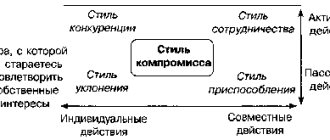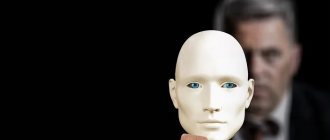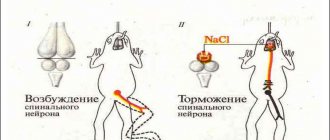What is a reflex?
A reflex is an involuntary reaction of the body to an external or internal stimulus, which occurs without thinking or making a decision. All multicellular organisms that have at least the simplest nervous system have reflexes. They are also present in humans. At the same time, some actions performed reflexively cannot be reproduced on purpose. Others we are quite capable of consciously controlling, but we don’t have to do this.
The term “reflex” is derived from the Latin word reflexus (reflection). Its author is considered to be the 17th century French scientist Rene Descartes. Since Descartes was primarily a physicist, he believed that a nerve impulse is reflected like a ray of light, which is why he chose this name.
All reflexes are divided into two groups:
- Unconditional (innate) . These are heritably transmitted reactions that are common to an entire species (or larger taxonomic category).
- Conditional (acquired) . These are reactions that are formed during life under the influence of higher nervous activity, but subsequently act without its participation.
Based on the definition, reflexes are characteristic only of multicellular organisms that have a central nervous system. That is, the ciliate slipper cannot have reflexes, no matter how much it moves its cilia, approaching food or escaping from danger.
Any living creature constantly carries out some kind of reflex actions. And the more complex the central nervous system is, the more predisposed this creature is to acquiring conditioned reflexes throughout life. However, even in humans, most of them are unconditional.
Pathological reflexes
Main article: Pyramid signs
Pathological reflexes are a neurological term that refers to reflex reactions that are unusual for a healthy adult. In some cases, they are characteristic of earlier stages of phylo- or ontogenesis.
Oral automatism reflexes are one of the manifestations of pseudobulbar syndrome, which occurs with bilateral damage to the pyramidal tracts going to the motor nuclei of the glossopharyngeal, vagus, accessory and hypoglossal nerves (caudal group of cranial nerves). These include: Proboscis reflex, Karchikyan's distance-oral reflex, Astvatsaturov's naso-labial reflex, Marinescu-Radovici's Palmo-mental reflex, Yanyshevsky's “Bulldog” reflex.
Pathological wrist reflexes include: Tremner, Jacobson-Lask, Zhukovsky, Bekhterev carpal-digital reflex, superior Rossolimo reflex, large-finger flexion reflex Klippel-Weil.
Pathological foot reflexes are divided into extension and flexion. The first include: Oppenheim reflex, Gordon reflex, Schaeffer reflex, Babinsky reflex, Chaddock reflex, Bing reflex, Strumpel reflex. The second include: the lower Rossolimo reflex, Bekhterev-Mendel Reflex, Zhukovsky-Kornilov Reflex, Bekhterev Reflex, Puusepp Reflex.
One of the pathognomonic signs of damage to the pyramidal tract is clonus. Manifested by rapid and rhythmic contractions of a muscle or group of muscles in response to their stretching. Foot clonus is caused by a patient lying on his back, and patella clonus is caused by a patient lying on his back with his legs straight.
Reflex friendly movement of a limb accompanying the voluntary movement of another limb is called Synkinesis. Synkinesis can be either physiological (for example, flapping your arms while running or walking quickly) or pathological. Pathological synkinesis is divided into 3 types: global synkinesis, imitation synkinesis, and coordinator synkinesis. Synkinesias develop not in the acute, but in the remote period of the underlying disease, which led to damage to the pyramidal tracts. Their pathogenesis is not fully understood. They are often perceived by patients with spinal injury as a sign of restoration of nerve conduction of the spinal cord.
How do reflexes work?
The natural meaning of a reflex is that certain events or external influences on the body require a specific response. For example, severe fear in most animals causes a release of adrenaline, increased muscle tone, and increased heart rate and breathing. All this is necessary to increase the chances of successfully repelling an attack or escaping.
To better understand what a reflex is and how it differs from instinct, you need to know its 5 main features:
- it is based on nervous excitement;
- the reflex cannot be spontaneous;
- there is always an irritant;
- the transformation of sensory excitation into effector excitation occurs without the participation of higher nervous activity;
- reflexes are necessary to quickly adapt to changing circumstances.
Instinct, unlike reflex, is not conditioned by anything. For example, fear is an instinctive feeling that ensures survival. Disgust is also an instinct designed to protect us from food poisoning or infection. The crying of a child, the desire to gather in groups, conforming behavior, the desire to dominate or occupy a higher position in the social hierarchy - these are all instincts.
The reflex can be triggered in response to a single stimulus or to a combination of several stimuli. For example, in the famous experiment of Academician Pavlov, a dog’s digestive process was activated in response to a bell. This is a reflex to a single stimulus.
This experiment can be complicated by developing a reflex that will work only in the presence of a certain combination or sequence of stimuli (for example, the simultaneous inclusion of sound and light or the sequential playback of several sounds).
Interesting Facts
There is an opinion that mental dependence on something is caused by the formation of a conditioned reflex. For example, mental dependence on drugs is due to the fact that taking a certain substance is associated with a pleasant state (a conditioned reflex is formed that persists for almost the entire life).
Candidate of Biological Sciences Kharlampiy Tiras believes that “the idea of conditioned reflexes with which Pavlov worked is completely based on forced behavior, and this gives an incorrect registration.” “We insist: an object must be studied when it is ready for it. Then we act as observers without violating the animal, and, accordingly, we get more objective results.”
Types of reflexes
There are different approaches to the classification of reflexes, but the most important is dividing them into conditioned and unconditioned. Let's look at each of these groups in detail.
Unconditioned reflexes
Unconditioned reflexes are innate reactions, genetically inherited from parents. For the most part , they persist throughout life , but some appear or intensify only in certain periods. Unconditioned reflexes are reproduced in every generation and in every representative of the species, even if he was separated from his mother immediately after birth.
The implementation of an unconditioned reflex does not require the participation of the cerebral cortex. The nerve impulses that cause them pass either through the spinal cord or through the brain stem (the part that connects the brain and spinal cord).
In the group of unconditioned reflexes, the following subgroups are distinguished:
- Food. This includes reflexes associated with eating and digesting food. When seeing appetizing food and inhaling its aroma, most mammals (and humans in particular) begin to actively salivate. At the same time, gastric juice is secreted in the stomach, as the body is already preparing to digest food.
- Protective. These are reflexes designed to protect the body from damage. The most obvious examples include blinking, squinting in strong winds, closing your eyes when diving, sneezing, coughing, and pulling your hand away from a burning object.
- Sexual This is a complex set of reflexes, covering body movements (courtship, mating dances, movement and approach), the launch of the necessary physiological processes and the mating process itself. Sexual reflexes are a reaction to erogenous stimuli (visual, tactile). They should not be confused with the sexual instinct (instinct is unconditional and determines which stimuli will be perceived as erogenous).
- Approximate. Pavlov called them “What is this?!” reflexes. Their essence lies in the fact that in response to an incomprehensible stimulus, the creature becomes alert: it freezes, squints its eyes, listens and prepares to react urgently.
A characteristic feature of unconditioned reflexes is that they are very difficult to control. This is because they are all necessary for survival , so when triggered, they completely control the behavior of most living beings for a short time.
Conditioned reflexes
This group includes acquired reactions. They are formed in a living creature during life and are not inherited, and in the absence of regular reinforcement they can weaken and be lost. Their action is best explained by the famous experiment of Academician Pavlov, the example of which is usually used to explain what reflexes are in school biology lessons.
The essence of the experiment is that the test animal (dog) sees a certain signal (light) or hears a sound (bell) every time before feeding. After some time, even in the absence of food, the animal's digestive processes begin to activate in response to light or a bell.
Many of our actions in everyday life are in one way or another connected with conditioned reflexes. For example, learning to ride a bicycle is quite difficult. But in the future this process does not cause any difficulties at all, and this is explained by conditioned reflexes. Our spinal cord “learns” to independently respond to loss of balance and instantly transfer the center of mass to the desired point. And this happens completely unnoticed by us.
Classification of reflexes
However, you can approach this issue in more detail and make a grouping according to a number of individual characteristics. For example, based on the type of receptors, reflexes are:
- exteroceptive (tactile, olfactory, visual, auditory);
- interoceptive (receptors of internal organs);
- proprioceptive (muscular, joint).
By type of effector:
- motor (somatic);
- vegetative (digestive, cardiovascular, sweating).
According to biological characteristics:
- protective;
- digestive;
- sexual
According to the passage of a nerve impulse (according to the location of reflex arcs):
- spinal cord reflexes (spinal);
- brain reflexes.
Let’s leave a detailed breakdown for particularly inquisitive readers, and we ourselves will consider the two enlarged categories of reflexes that Pavlov identified.
Reflex arc
It takes us about 500 milliseconds to respond to an event with a basic decision. If a decision does not need to be made, we can react in 100-200 milliseconds. At the same time, some reflexes work tens of times faster, and this is only possible due to the fact that thinking is not involved in this process.
A reflex is a reaction to an external influence that occurs without involving the cerebral cortex in this process (the nerve impulse passes through the spinal cord or stem). The path that the impulse travels is called a reflex arc. For example, if a person withdraws his hand from a burning object, the reflex arc includes the following elements:
- receptor (nerve endings in the finger that generate an impulse);
- afferent link (sensory neuron going to the spinal cord);
- the nerve center that determines the response (a small complex of neurons in the spinal cord);
- efferent link (motor neuron transmitting a signal to the muscle);
- effector (muscle that withdraws the hand).
The reflex arc provides an emergency response to a dangerous impact even before the person realizes that he has been burned. Because this reaction is not meaningful, in some cases it can lead to an undesirable result (for example, by withdrawing a hand, a person may push someone, lose balance, or get hurt).
Historical information
The concept of reflex first appeared in the physics of Descartes. Descartes developed a general mechanical picture of the world and wanted to include in it the behavior of living beings. Descartes' concept was created in an era when various scientists gave materialistic explanations for phenomena occurring in nature: for example, physician William Harvey discovered and described the circulatory system, in which this system acted as a simple mechanism with elements known to mankind at that time - a pump, "pipes" ", etc. Descartes' theory further strengthened the principle of materialistic determinism, since Harvey considered only the internal structure of the animal's body as a mechanism, and Descartes also transferred this principle to the interaction of organisms with the outside world, that is, in fact, to the mental activity. Descartes believed that the interaction of organisms with surrounding bodies is mediated by a nervous machine, in which the brain serves as the center, and “neural tubes” diverge from it. According to his scheme, external factors act on the ends of nerve “threads” located in the body, which, when stretched, open the valves of the holes leading from the brain to the nerves. Through these open channels, “animal spirits” (Descartes’ expression) rush into the corresponding muscles, which as a result “inflate.” Thus, Descartes argued that the cause of a motor act is not a product of the brain or soul, but lies externally, outside the organism. Descartes' work was the result of the inspiring influence of Harvey: Descartes wrote that from the movements of the circulatory organs "as the first and most general thing observed in animals, one can easily judge everything else." Although Descartes did not have the term “reflex”, he managed to outline the contours of this concept quite clearly: I. P. Pavlov considered Descartes the founder of the concept of “reflex” in physiology and wrote that “Considering the activity of animals, as opposed to human, as machine-like, Descartes... established the concept of reflex as the main act of the nervous system."
The assumption about the completely reflex nature of the activity of the higher parts of the brain was first developed by the scientist-physiologist I.M. Sechenov. Before him, physiologists and neurologists did not dare to raise the question of the possibility of a physiological analysis of mental processes, which were left to psychology to solve.
Further, the ideas of I.M. Sechenov were developed in the works of I.P. Pavlov, who discovered the ways of objective experimental research of the functions of the cortex, developed a method for developing conditioned reflexes and created the doctrine of higher nervous activity. Pavlov in his works introduced the division of reflexes into unconditioned, which are carried out by innate, hereditarily fixed nerve pathways, and conditioned, which, according to Pavlov’s views, are carried out through nerve connections formed in the process of individual life of a person or animal.
Charles S. Sherrington (Nobel Prize in Physiology or Medicine, 1932) made a great contribution to the formation of the doctrine of reflexes. He discovered coordination, mutual inhibition and facilitation of reflexes.
Creators of the science of reflexes
The term and the very concept of a biological reflex were introduced into science by the French philosopher, physicist and mathematician Rene Descartes (1596-1650). He described the external manifestations quite accurately, but his understanding of the physiology of these processes was far from the truth. Therefore, he is usually not included in the list of scientists who created the doctrine of reflexes.
The creator of this theory is considered to be the Russian scientist Ivan Sechenov (1829-1905). His ideas were developed and supported by real experiments by Vladimir Bekhterev (1857-1927) and Ivan Pavlov (1849-1936). Despite the fact that Bekhterev is mentioned less often in this context than Pavlov, his contribution is also enormous. It was he who created reflexology (a branch of psychology in which all higher nervous activity is considered as a set of reflexes).
Pavlov is known for his practical experiments, as well as for dividing conditioned and unconditioned reflexes. He conducted a huge number of experiments on animals, studying their reactions to various stimuli.
At the same time, the most famous was, of course, the experiment with a bell that caused the dog to secrete saliva and gastric juice. Having conducted experiments on different animals, Pavlov became convinced that conditioned reflexes are always formed if the stimulus for the animal is sufficiently unambiguous.
Literature
- Skoromets A. A., Skoromets A. P., Skoromets T. A.
Propaedeutics of clinical neurology. St. Petersburg: Politekhnika, 2004 - Kositsky G.I.
, “Human Physiology”. Ed. "Medicine", 1985. - Dictionary of physiological terms / resp. ed. Gazenko O.G. - M.: “Nauka”, 1987. - 32,000 copies.
- Fundamental and clinical physiology: Textbook for students of higher educational institutions / ed. Kamkin A.G., Kamensky A.A. - M.: Publishing Center "Academy", 2004. - 1072 p. — 5,000 copies. — ISBN 5-7695-1675-5.
- Nozdrachev A.D., Barannikova I.A., Batuev A.S.
and others. Physiology of the nervous, muscular and sensory systems // General course of human and animal physiology. In 2 books: Textbook. for biol. and honey specialist. universities - M.: "Higher School", 1991. - T. 1. - 512 p. — 48,000 copies. — ISBN 5-06-000650-6. - Sergeev B.F.
Stages of evolution of intelligence. - M.: Nauka, 1986. - 192 p.











